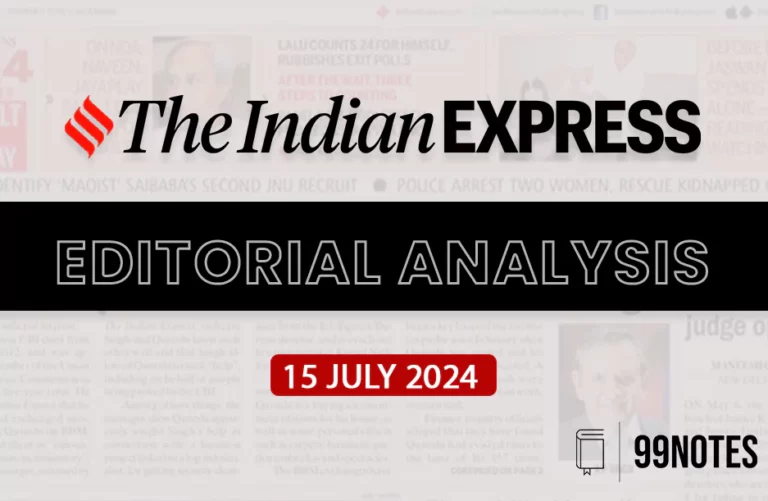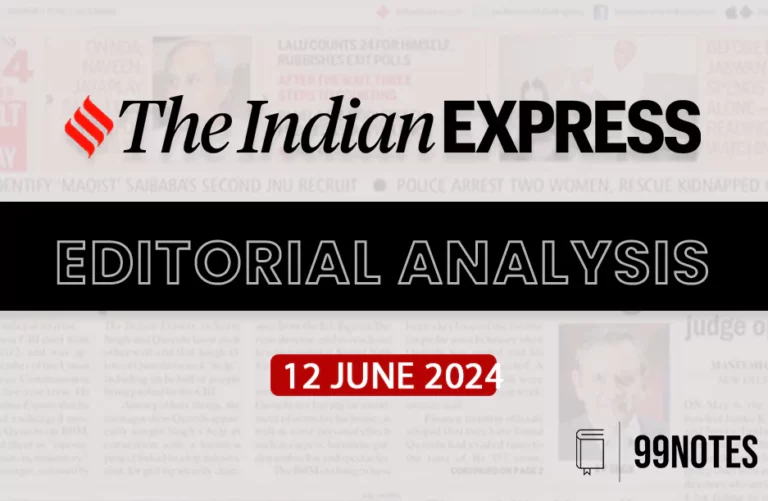2 May April 2024 : Indian Express Editorial Analysis
1. The trade push
| Topic: GS3 – Indian Economy – Effects of liberalisation on the economy
This topic is relevant for both Prelims and Mains as the article discusses global trade trends, including factors affecting trade volumes and export earnings. |
| Context: |
|
Global Trade Volatility:
- Global trade has experienced significant fluctuations in recent years due to various factors such as the Covid-19 pandemic and geopolitical conflicts.
- The data from the United Nations Conference on Trade and Development shows a continuous decline in the value of global merchandise trade since the middle of 2022, with a notable 6% decrease in global merchandise exports in 2023.
India’s Performance in Global Trade:
- India’s performance in global trade aligns with this trend, with merchandise exports falling by 7% in 2023.
- Despite this decline, India outperformed developing Asia as a whole, which saw a 8% decrease in merchandise exports.
- However, there were signs of improvement in the January-March 2024 quarter, with sequential growth observed.
Factors Impacting India’s Exports:
- India has faced challenges in the global trade environment, including lower international commodity prices, particularly in energy and non-energy sectors.
- The decline in crude oil prices significantly contributed to the fall in India’s overall merchandise export bill.
- However, despite lower prices, India managed to increase the volume of petroleum exports.
- Excluding petroleum and gems and jewellery exports, core exports increased by 1.4%, indicating higher shipment volumes of goods.
Export Sector Analysis:
- Several key sectors in India’s export portfolio experienced growth, including electronics, drugs and pharmaceuticals, engineering goods, and agricultural products.
- The electronics sector, in particular, saw a notable 24% growth, driven by exports of telecom instruments and mobile handsets incentivized by government schemes.
- Despite bans on certain agricultural products, overall agriculture and allied exports saw healthy growth, driven by categories such as meat and poultry products, spices, fruits and vegetables, oil meals, oilseeds, and unmanufactured tobacco.
Destination of India’s Exports:
- India’s export destinations varied, with a decline in exports to the US, despite solid economic growth in 2023, primarily due to the dominance of the services sector.
- However, exports to the Euro region increased despite economic slowdowns and geopolitical uncertainties.
- Additionally, exports to the Gulf Cooperation Council (GCC) countries, particularly the UAE, rose significantly.
Concerns and Priorities:
- While overall export growth is positive, there are concerns about the decline in labor-intensive sectors such as gems and jewellery, textiles, leather, marine products, and plastics.
- The share of these sectors in India’s merchandise exports has decreased over the last decade, highlighting the need to address this decline as a priority.
Future Outlook for India’s Exports:
- Despite challenges, there are positive indicators for India’s exports, including upward revisions to global growth and trade projections by multilateral agencies.
- Bilateral free-trade agreements and efforts to boost manufacturing are expected to further stimulate India’s exports in the near to medium term.
- However, uneven global growth and geopolitical tensions remain potential spoilers that need monitoring.
Conclusion:
- India’s export performance reflects global trade dynamics, with challenges posed by factors such as the Covid-19 pandemic, geopolitical conflicts, and fluctuating commodity prices.
- While certain sectors have shown resilience and growth, there are concerns about the decline in labor-intensive industries.
- However, with supportive measures and favorable global projections, India’s exports are expected to contribute positively to overall growth momentum in the coming years, though vigilance against potential disruptions remains essential.
| How does Economic Slowdown Impact International Trade and Individual’s Purchasing Power? |
|
| PYQ: With reference to the international trade of India at present, which of the following statements is/are correct? (2020)
1. India’s merchandise exports are less than its merchandise imports. 2. India’s imports of iron and steel, chemicals, fertilizers and machinery have decreased in recent years. 3. India’s exports of services are more than its imports of services. 4. India suffers from an overall trade/current account deficit. Select the correct answer using the code given below: (a) 1 and 2 only (b) 2 and 4 only (c) 3 only (d) 1, 3 and 4 only Ans: D |
| Practice Question: Discuss the trends and challenges in India’s merchandise exports over the past few years, considering the global trade environment and domestic factors. Also, analyze the sector-wise performance of India’s exports and the implications of destination diversification. (250 words/15 m) |
2. A tax on aspiration
| Topic: GS3 – Indian Economy – Government Budgeting
This topic is relevant for both Prelims and Mains as the article discusses the concept of inheritance tax and its implications on wealth distribution, economic growth, and middle-class aspirations. |
| Context: |
|
What is Inheritance tax?
- This tax is imposed on those who inherit assets from a deceased person.
- The rate of this tax depends on the value of the property received by the heir and his relationship to the decedent.
- This tax is a form of death tax.
Debate on Inheritance Tax:
- The concept of inheritance tax, sparked by Congress leader Sam Pitroda’s suggestion for its implementation, has brought this policy tool into the spotlight once again.
- Pitroda referenced the US example, where the government levies a 55% tax on the deceased’s wealth, while the remaining 45% is distributed among legal heirs or children.
- However, the Congress party distanced itself from Pitroda’s views, emphasizing that they are his own and do not represent the party’s stance.
Global Context of Inheritance Tax:
- Inheritance tax, also known as estate tax or death tax, exists in various forms across several countries, including South Africa, Brazil, and the US.
- However, emerging economies like India and China do not have provisions for such a duty.
- Examining the wealth distribution among the top 10% of the population in different countries reveals that an inheritance tax may not necessarily lead to equitable wealth distribution, as it is higher in countries like South Africa, Brazil, and the US compared to India and China.
Why has there been growing demands for the implementation of Inheritance Tax in India?
- Rising wealth and income inequality in India– In the post-liberalisation period of the Indian economy, the wealth and income inequality has been rising in India. According to Credit Suisse 2018 Global Wealth Report, the richest 1% own 51.5% and the richest 10% account for 77.4% of the nation’s wealth. Bottom 60% of the population own only a meagre 4.7% nation’s wealth.
- Lack of Inclusive Growth– The Gini wealth coefficient in India has gone up from 81.3% in 2013 to 85.4% in 2017 (100% represents maximal inequality). The growth in India has not been inclusive.
- Endowments to Social Sector Institutions– Indian hospitals, universities, and other institutions need endowments and funds from inheritance tax. For ex- Harvard University receiving funds from estates, is exempt from Inheritance tax.
- Need for more direct taxes– The government’s fiscal deficit has increased after the COVID-19 pandemic. Hence, additional sources of direct taxes like inheritance tax need to be explored to contain the fiscal deficit as mandated by the FRBM Act.
- International practices– Developed countries such as England, France, Germany, the USA and India’s South East Asian counterparts like Philippines, Taiwan and Thailand have been charging inheritance tax.
Challenges and Implications of Implementing Inheritance Tax:
- Implementing an inheritance tax may present several challenges and implications, particularly in countries like India.
- Wealthy individuals can easily avoid inheritance tax by utilizing tax-exempt assets or transferring their wealth before death.
- Furthermore, an inheritance tax could disincentivize wealth accumulation and investment, potentially hindering entrepreneurship and capital formation.
- It may also lead to the forced sale of assets to pay taxes, disrupting family enterprises and resulting in inefficient asset allocation.
Administrative Burdens and Resistance:
- In addition to economic concerns, an inheritance tax could impose significant administrative burdens, particularly for widows and non-resident Indians.
- Tax regulations and procedures may exacerbate emotional and financial stress, highlighting the need for simplified and accessible tax frameworks.
- Moreover, taxpayers may resist inheritance tax due to its visibility and perceived burden, leading to distorted perceptions of fiscal policy.
Impact on Middle-Class Aspirations and Economic Growth:
- The introduction of inheritance tax may negatively impact middle-class aspirations and wealth creation efforts.
- It could discourage savings and investment, slow down economic growth, and drive talent and capital flight abroad.
- Enforcement challenges and tax avoidance strategies may further limit revenue generation.
What are the benefits of Inheritance Tax?
- Reduction of inequalities-The inheritance tax reduces Intra-Generational Inequality and promotes Inter-Generational Equity by preventing the concentration of income and wealth in the hands of a few.
- Greater financial resources for Govt- According to an Oxfam Survey of 2018, 51 of a total of 101 billionaires are more than 65 years old and collectively own ₹10.54 trillion. A moderate inheritance tax of 10-15% (like other Asian countries such as the Philippines, Taiwan and Thailand) can act as a stable and significant source of revenue for the government.
- Greater Revenue to fund public welfare- Inheritance tax provides additional sources of revenue to the government for expansion of social sector programmes, and its push towards universal health insurance.
- Creation of meritocratic society-It will help in creation of a meritocratic society by chipping away the advantages the children of the wealthiest families enjoy by accident of birth. The redistribution of initial endowments can help in the establishment of optimal social state.
- Progressive in nature-Inheritance tax is a progressive tax as it places a higher tax burden on wealthy individuals only.
Conclusion:
- While the debate on inheritance tax continues, its implementation poses complex challenges and implications for countries like India.
- Balancing the need for wealth redistribution with concerns about economic growth and middle-class aspirations is essential for effective policymaking.
- Ultimately, inclusive wealth creation efforts and innovative economic policies are crucial for achieving long-term prosperity and reducing wealth inequality.
| History of Inheritance Tax in India |
|
| Practice Question: What is inheritance tax, and why has it recently sparked significant debate in India? Discuss the potential implications of implementing inheritance tax on wealth distribution and economic growth in the country. (250 words/15 m) |



